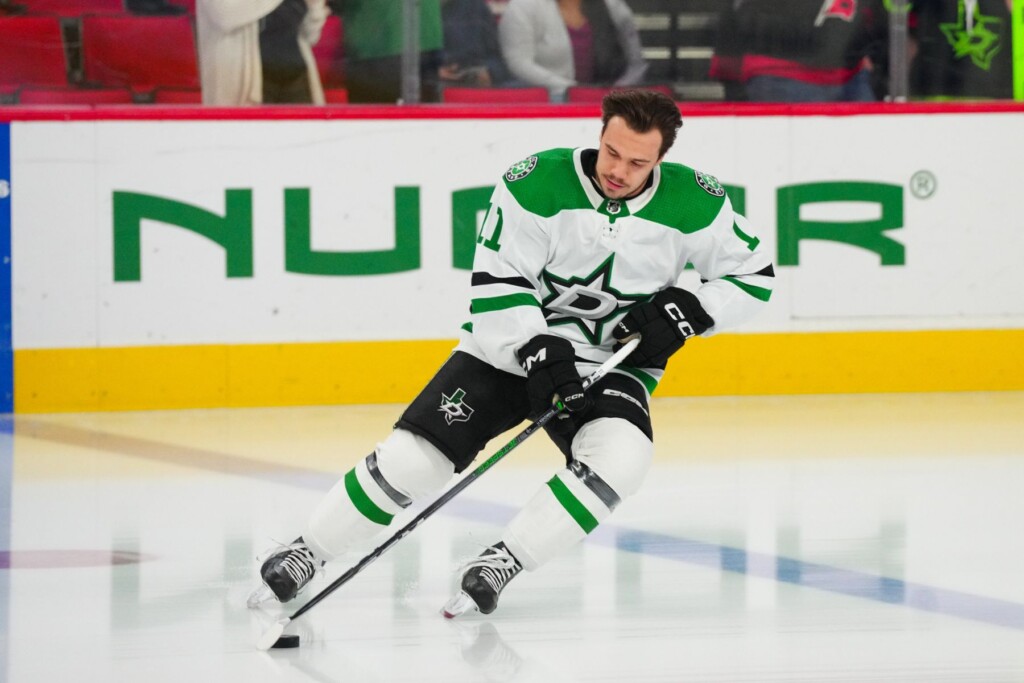The Stars are bouncing around the West’s upper crust—currently in second place in the Central, with potential to climb up to first or drop to third on any given night. Wherever they ultimately land, know that their record won’t do justice to their final form. Jim Nill already addressed the biggest need by trading for top-four blueliner, Chris Tanev, in a masterclass in fleecing. While there’s still potential for Nill to perform some more handiwork before the Friday trade deadline, another move is already paying off.
We’re talking, of course, about Logan Stankoven. The comparisons to Thomas Harley are too apt to ignore. When Harley returned to the big club last season in early April, expectations were high. Pete DeBoer had glowing praise for the 18th overall pick from 2019, even though he was a young player with minimal NHL experience and zero playoff minutes. We know how that story ended. Might Stankoven be following a similar script?
This isn’t about Stankoven’s future, or his potential. This is about the very real impact the 47th overall pick from 2021 is already having in a stacked forward corps.
The Stars’ identity and strength has come from their forward depth. As we’ve noted, 15 percent of the teams with at least six 20-goal scorers within the last 23 years have reached the Stanley Cup Finals. The Stars are on pace to have seven. In many ways, Stankoven’s presence solidifies that edge. After all, the trio of Wyatt Johnston,Jamie Benn, and Evgenii Dadonov has largely underperformed. Last year the Stars were on pace for 59 goals with those three on the ice. This year they’re on pace for 18. With Dadonov sidelined indefinitely due to a lower-body fracture, Stankoven stepped in. He, Benn, Johnston would put the Stars on pace for 33 goals, and that’s while controlling 64 percent of the expected goal share—by far the best among Dallas’ regular trios.
That point deserves some emphasis because we’ve already seen DeBoer reckon with it: the top line starring Roope Hintz, Jason Robertson, and Joe Pavelski is playing like anything but. Yes, the Stars are outscoring opponents with them on the ice, 31-26, but it’s not just below their own standards, it doesn’t even qualify as “top.” The Matt Duchene-Tyler Seguin-Mason Marchment line has been on for 38 goals for and 16 goals against, but they’re cooling off, too, scoring just two goals in their last five games and below average across every conceivable possession metric.
So the 21-year-old Stankoven couldn’t have arrived at a better time. Just as Harley next to Heiskanen gave Dallas the ability to dominate from the back end, Stankoven could factor into establishing a dominant forward trio should injuries occur, or should DeBoer feel the need to further tinker with his groups.
If we want to get into the deep cuts of how Stankoven improves the team, which I would argue reflects the depth of his talents, there’s yet another layer that he can prove key to. The Stars are kind of a weirdo team in that they don’t generate a lot of chances on the rush, but they capitalize when they do. Per Corey Sznajder’s tracking data, Dallas is fifth in rush shooting percentage, in the company of some good teams like Vegas and Vancouver, some bad teams like Arizona and Buffalo, and some mid-tier teams like Detroit and Philadelphia. Given that the rush accounts for more than a quarter of a team’s chances, any regression could sting, especially against teams that attack with speed more consistently. Per Natural Stat Trick, Stankoven is on pace to be the Stars’ rush leader, which is in line with how he excelled in the AHL, teleporting from zone to zone like a Street Fighter character.
This might seem unfair to Stankoven. Why rush to make such proclamations? Why hype the kid up? I would counter with this: how is this any more unfair than treating Tanev like the blueline’s support messiah? In both cases, we’re talking about saddling one player with the weight of expectations. However, we’re also talking about the talents that make each an impact player. Yes, one guy is older, and the other is younger, but this means nothing in the context of performance. You can blame the NHL for helping to shape your skepticism, but just because young players are cynically managed into an NHL lineup doesn’t make that skepticism valid. Just look at young players like Brock Faber in Minnesota, Tyson Foerster in Philadelphia, and Harley in Dallas. Why can’t Stankoven fall into that group?
This is, after all, a player who was too good for the WHL. When the WHL couldn’t challenge him, he went to the AHL, where his dominance proved too much for that league, too. As it stands, the only prospects whom draft experts rank ahead of Stankoven are all former top-five and top-10 picks. It’s not just Stars fans who know what’s up, but also the rest of the world. Because of that, we’re way past giving Stankoven credit for “staying on the roster.” He has done much more than that, and it’s evident in every shift that defenders either struggle with him in the corners or when forwards are racing to catch him in transition.
The 2017 draft will always be Nill’s crown jewel, quite possibly one of the most absurd hauls of all time. But consider the haul that the 2021 draft has brought: Johnston, Stankoven, and the second-rounder (Artem Grushnikov), who made the Tanev trade possible.
If it looks like I’m implying Stankoven is Dallas’ forward savior, maybe I am. Maybe I’d go so far as to argue he has Conn Smythe potential in him. For now, what’s more important than my bombastic estimation is that his presence highlights a low-key flaw in the Stars’ forward core: Dallas’ top lines aren’t controlling play. In fact, neither the Hintz line nor the Duchene line factor into the top 30 forward trios with at least 200 minutes together when measuring them by expected goal differential. Tantalizing as he is, maybe Stankoven pops a little less out of the gate in a more perfect status quo.
But isn’t that what we said about Harley before he became an essential part of the blueline? Am I supposed to believe that Stankoven, who reminds me less of some perfunctory hockey comparable and more like Barry Sanders with his combination of speed and toughness, can’t achieve comparable success?
That’s the potential we’re talking about. You can call it hype. I call it the tape.
At 5-foot-8, Stankoven is obviously not the biggest player on the roster, but I can’t think of any player who’s making a bigger impact. Don’t expect that to change.
Author







